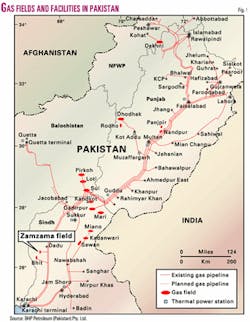A group led by BHP Billiton Ltd., Melbourne, is moving toward the $100 million first phase development of Zamzama field, Pakistan's fourth largest gas field in terms of reserves.
Ultimate recovery is placed at 1.7 tcf proved and probable. Plateau production is expected to be 300 MMcfd of gas and 2,000 b/d of condensate for 10-12 years.
Production start is set for late 2003, and field life is 15-25 years.
Zamzama field was discovered in 1998 on the Dadu concession in Sindh Province 200 km north of Karachi. An extended well test (EWT) began in March 2001 (OGJ Online, Mar. 14, 2002), and lately production has averaged 100 MMcfd from the Zamzama-1/ST1 and Zamzama-2 wells.
Pakistan has more than 20 tcf of proved gas reserves and produces 700 bcf/year, all consumed domestically. The three largest producing fields are Sui at 750 MMcfd, Mari 500 MMcfd, and Qadirpur 300 MMcfd.
The oil and gas ministry has forecast a 50% increase in internal gas demand by 2006, which the government hopes to satisfy via domestic developments such as Zamzama (OGJ, Jan. 28, 2002, p. 24).
Exploration history
Zamzama field is BHP's first commercial production in Pakistan.
The discovery well went to 3,938 m. It found hydrocarbons in the Cretaceous Khadro and Pab sandstones, and wireline logs confirmed a gas column of more than 300 m.
After acquisition of 3D seismic data, Zamzama-2 went to 3,933 m. It confirmed the Khadro and Pab hydrocarbons, found a hydrocarbon column thicker than 350 m, and flowed gas at a Pakistani record of more than 90 MMcfd.
Field area is about 120 sq km. Beyond the 1.7 tcf in the core area, a further possible resource of 1.3 tcf has been identified in the undrilled footwall to the east and the northern Phulji areas of Zamzama field.
Gas in the Pab reservoir at 3,500 m is sweet and dry with a gross heating value of 800 BTU/scf due to 21% nitrogen content.
The joint venture invested $52.4 million from 1993 through March 2002 for exploration, appraisal, and the EWT facilities.
Phased development
Under the EWT scheme, gas is treated at a minimum processing facility for dehydration, dew point control, and condensate stabilization before being compressed and delivered 8 km to the main Sui Southern Gas Co. Ltd. Sui-Karachi gas pipeline.
The gas is sold to Sui Southern under a 21-month contract that will remain in force until new sales agreements that relate to field development kick in.
BHP said the EWT was integral to the management of technical and commercial risks associated with field development. It provided valuable long-term well and reservoir productivity data while securing a market position.
At least three development wells will be drilled in the core area. Development will involve a dual-train facility that largely incorporates the EWT plant.
Stabilized condensate will be shipped via small diameter pipeline connecting with the Pak-Arab Refinery Co. pipeline 40 km west of the Zamzama plant. Condensate will be refined at PARCO's Muttar refinery in Punjab Province.
Field operating costs are put at $7 million/year.
Other recent gas discoveries in the area include Bhit, Kadanwari, Sawan, and Miano fields.
Participants in the Zamzama development are BHP 47.5%, ENI SpA's Lasmo (MP) Ltd. unit 23.75%, PKP Exploration Ltd. (formerly Premier Exploration Pakistan Ltd. 23.75%, and Government Holdings (Pte.) Ltd. 5%.
Assuming that Government Holdings exercises its option to acquire a further 20% equity, interests would become BHP 38.5%, Government Holdings 25%, PKP 18.75%, and LASMO 17.75%.



